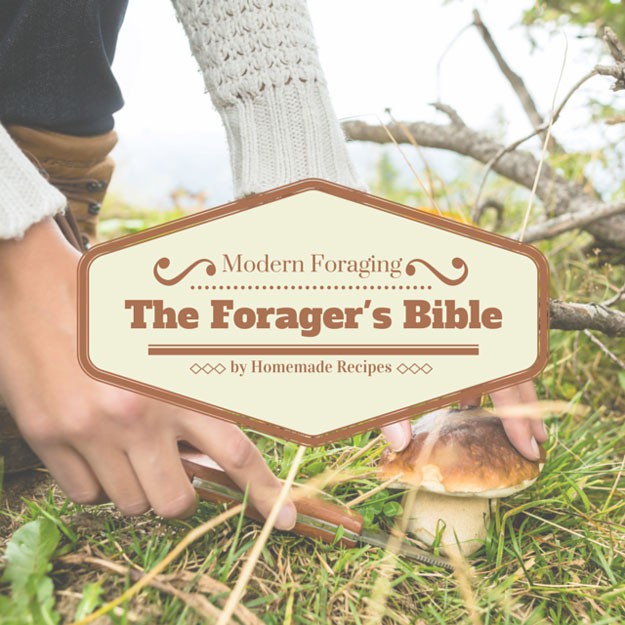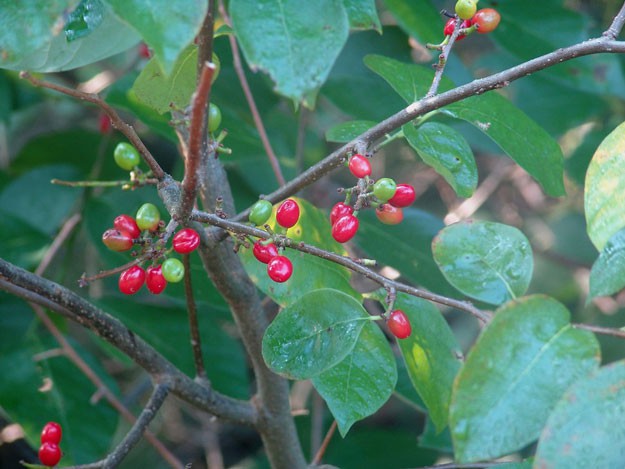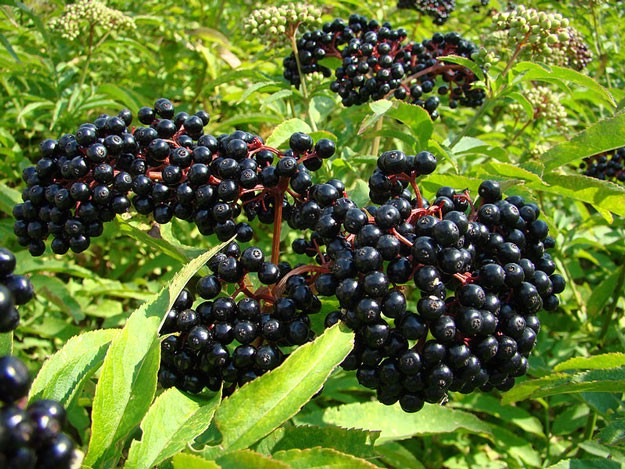Learn to identify the most commonly found edible wild fruits such as blueberries, persimmons and more.
Chapter 2: Naming the Edible Wild Plants
2.3 – Fruits
Blueberries
Blueberries are one of the most popular fruits of the summer. In comparison to cultivated blueberries, wild blueberries are smaller in size. However, they are no less abundant in the areas that they grow. There are more than four hundred species of blueberries all across the Northern Hemisphere! Blueberries are not just in shades of blue; they may also come in red, like the lingonberry. Other species are known as deerberry, bilberry, whortleberry, sparkleberry, and the list continues. How many berries do you think you tried?
Common Name: Vaccinium corymbosum, also known as Highbush blueberry; Vaccinium angustifolim, also known as Lowbush Blueberry
Location: You can find blueberries in Eastern North America, Europe, and Asia.
Description: There are two types of bush berries. The small trees are the low growing bush berries that have alternate, simple and blunt edged leaves. The flowers bear a resemblance to a bell. They are colored white during the spring and blue in the summer. The other types are known as high bush berries that carry the same characteristics, but the lay high instead of low. Blueberries tend to get mixed up with its related species, the huckleberries.
When to Find It: The flowers are easy to recognize come spring time. You will want to remember those spots and come back when it is summer when they have ripened. High bush blueberries are in areas where the soils have moisture, such as in wet woods, or by streams. They also can be planted in urban parks. Opposite, the low bush, blueberries are commonly found in dry terrains such as hiking trails and woodlands.
Eating the Plant: Bring a sturdy container with you when you are ready to collect the blueberries. Do this when they are ripe. All you need is patience and a good set of hands ready to do the works. Blueberries are fruits that may be consumed raw or you can add them to several dishes. Most people will use them in their pies, beverages or will make jelly out of it.
Roses
When most people think of a rose, they think about the flower alone that you will pick and give to someone during certain special events. However, there are over one hundred species of roses that we know of, all with its unique characteristics. Besides using roses for beauty and fragrant perfumes, they are a great edible plant to consume.
Common Name: Rosa rugosa
Location: Roses are native to eastern Asia and are still highly common there, namely along the sand dome. You will also find them in the northeastern parts of North America.
Description: Roses are a prickly shrub with compound leaves that are jagged. It possesses either a big white or pinkish flower that has about five petals each. Within the shrub, there is also a cherry tomato sized fruit called hips which open underneath. The fruit has a vast number of tiny, hairy “seeds” that are, in fact, fruits that hold the seeds.
When to Find It: The flowers begin to bloom during the end of May and continue up until August, or the around fall. Rose hips are ripe when they are red in appearance and firm to the touch.
Eating the Plant: You can collect the rosehips once you see they are ripe and red. You need to cut the fruits in half and clean them. Both the bottom end and the hairy seeds inside or the plant need to be extracted. When it is clean, you can turn the pulp to create a yummy rosehip soup or jelly. When you are thinking about making the pedals for jelly, remember to scissor away the bitter tasting nub at the end of the base. There is also a range of rose hip products in supermarkets that are sold such as rose water and rose hip tea that you could make from scratch.
Spicebush

image via New England Wild
There were ancient pathways that bridged the spices of Eastern society with markets of the Western society. If those spices were to be instantly no longer available, people would begin to look for alternatives, such as the case with wild allspice, or Spicebush. There are over one hundred species of shrubs and little trees that originate from eastern Asia and eastern North America. They are excellent for using when making perfume as well.
Common Name: Lindera benzoin
Location: Spicebush is common in North America as it is native to that land. You can also find other species in the Americas and eastern Asia. These berries are not known to available in stores.
Description: This shrub carries two households of male and female plants. Yellow flowers start to appear before the leaves become noticeable during April, but it is solely the female, that’s that can make the red berries during the fall. The leaves are plain, unlobed and have blunt edges that are in an arrangement that is opposite facing manner on the branches. If you were to take a good look at the branches, you would see that they are spotted.
When to Find It: The flowers start to bud during spring, in late April and early May. Spicebush shrubs grow in the wet woods. By the time the end of summer is near and early fall begins, the fruits become a shade of red atop the branches. It is a signal that they are ripe and ready.
Eating the Plant: It is simple to gather spicebush berries; once you can locate a couple of female bushes that contain red fruit around early fall, you can pick them. You can dry the berries, powder them and store them for a delicious spicy flavored seasoning, which is referred to as “allspice” in the kitchen. It may also be used in tea, spice cakes, or icing.
Wintergreen
You can easily overlook this bush in the eastern forests of the United States. Ever heard or chewed wintergreen bubblegum? You guessed it – they extracted the flavor from these berries to put in their products or to flavor candy.
Common Name: Gaultheria procumbens
Location: It is primarily in eastern North America, however, other species of its kind are located in eastern Asia, western North American, Australia, South America and New Zealand.
Description: Wintergreen leaves are small, shiny and oval shaped. The flowers are usually white and bell-shaped, they are in a downward position where finally, the red, fragrant berries are nuzzled in between.
When to Find It: The berries ripen during the late summer and fall season. You can commonly find them in woodlands,
Eating the Plant: You can pick the berries with your hands, and you can use scissors to cut the leaves. You do not want to lift up the wintergreen. Once you wash them, you as eat them raw or get fancy with it and brew it into a tea.
Dogwood
The name “dog-tree” was added to the English vocabulary during the 1500s and become “dogwood” in 1614. Its fruits are dubbed dogberries. This tree is very appealing to the eye by anyone who passes by it. It is nice to know they are as good as they look too.
Common Name: Cornus Species
Location: There are several species of dogwood and depending on which it is, determines where you are likely to find it. You can find Cornus sanguinea in Eurasia and eastern North America; you can find Cornus nuttallii in western North America; you can find Cornus kousa in eastern Asia.
Description: Dogwoods have plain, non-toothed leaves where veins start to curve as it meets the leaf margin. Most species have the same characteristics of opposite leaves while others have alternative leaves. The flowers have four sections and are usually born individually in open bundles. Other species flowers may also be tightly bundled. The fruits of all species are drupes that have one to two seed, often shiny in color.
When to Find It: This beautiful white flowering treat is often a sign of spring. Before the flowers can bloom, another dogwood, the Cornelian cherry native to southern Europe, must release small masses of yellow flowers during the end of winter.
Eating the Plant: Dogwood fruits are uses shrubs in the ground you can easily pick and collect with your hands. Some dogwoods are large trees you will have to gather with a bit more effort. There are some species that are edible, but do not have much flavor to them. The most popular dogwood to eat is the Cornus mas and the Cornus kousa because they are very sweet. You can eat them as is after washing them or turn them into a jam. Some places ferment them for wine.
Elderberries

image via Wikipedia
If you were to question the average person about elderberries, they are likely going to reply about its association with wine or liquor. There are various species of black elderberries where the flowers’ juice is extracted to make a late spring alcoholic beverage. Elderberries are not just for drinking; they can also be used as food and into tasty dishes. The red-bellies elders are common in certain areas. However, there is some disagreement about its digestibility. It sparks caution in safely claiming them to be edible.
Common Name: Sambucus nigra
Location: Elderberries are distributed all across the Northern Hemisphere and in South America.
Description: The leaves of elderberries are opposite and compound with jagged leaves. It contains dozens of flat-topped white flowers during the month of June. By the time it is August; black, seedy berries make its appearance in the masses.
When to Find It: The flowers begin to bud around June, the beginning of summer and the berries start to ripen around the end of July through August. You can find them along less traveled roads and in riparian areas. They usually enjoy damp soil with plenty of sunshine
Eating the Plant: The berries can easily be picked using your hands. You can also cut the umbel stems to collect the clusters in bundles, which will be much quicker. It is highly known to be used in alcoholic beverages and juices, but you can also use the fruit to make jelly. You can also buy the jelly in general farmers’ markets. The flowers can be better fried and consumed for a tasty treat. You do not want to eat the branches or the leaves as they are poisonous. The small stems that remain on the berries, however, are safe to eat.
Ginkgo
If you have ever visited a Chinese restaurant, chances are you have likely noticed a dish known as Buddha’s Delight. It is a combination of veggies that have ginkgo nuts that taste like chickpeas. These nuts are very important to the Chinese that it is part of the dishes served when celebrating the New Year. Ginkgo has been discovered to be extremely effective in warding off the negative results of pollution and is often used for this purpose. Ginkgo is known for having smelly fruits.
Common Name: Ginkgo biloba
Location: They originate in China. However, it is been distributed and grown in the Northern Hemisphere across northern temperate zones as well as urban and suburban areas.
Description: It is an ornamental that is plotted in many areas. The leaves or fan-shaped and the trees are either male or female. The male trees are usually vertical, whereas the female trees are more horizontal and are the fruit bearers. The fruit is not appealing though it is fleshy it has a foul smell to it that can turn just about anyone off from eating it.
When to Find It: People begin to gather the ‘nuts’ when the fruits fall on the ground that takes places during mid-fall and rises during late fall.
Eating the Plant: You will want to wear gloves to remove the soft exterior to get to the nut like shell. Slice open the shell to see a see that is wrapped around a thin membrane very carefully. There are some people are can ingest gingko just fine, but are allergic to the fruit when is is unprocessed and develop rashes. Many people collect ginkgo for its nuts.
Sumac, Rhus-Juice
It may come off as strange to hear a plant family that consists of poison ivy, poison oak, and poison sumac could ever include substances that are safe to eat. Believe it or not it is edible, and this plant proves it.
Common Name: Rhus glabra and Rhus Sumac
Location: Scattered throughout the United States as a roadside weed. It is a native plant of the United States. Sumacs are within temperate and subtropical areas in the United States and Mediterranean countries.
Description: It has shrubs with smooth or wooly branches. The leaves are compound with jagged leaflets with red, fuzzy fruitcones that the shrubs make during summer.
When to Find It: When it is middle to late summer you will want to begin searching for the cones. There is no way to miss them – they are bloodshot red found in most roadside or waste areas and inplaces that are dry.
Eating the Plant: When are cones are ripe they can easily be broken off from the plant. Place the cones in containers that are fullof water, four cones per quart of fluid, and shake it for five to ten minutes. Lastly, you will want to strain the solution and sweeten as needed. The fruit of the plant is used to make delicious lemonade like beverages.
Persimmons
If you grew up in locations where persimmon trees were not a common thing, you probably never had these during your childhood, but maybe you still might have heard of them. Wild persimmons are typically very astringent, so there are few people who enjoy its flavor even though they are one of the best edible foods out there when ripe.
Common Name: Disopyros virginiana
Location: They are primarily in North America from New York to South Florida and western areas in California. The wild species in the United States have related species that also grow all over the Northern hemisphere.
Description: The trees are tall with distinctive deep fissures. The bark is in segments with leaves that are smooth edged, oblong and face alternately. The leaves are yellowish orange in color; some are green. The female trees produce fleshy orange fruit that are at least one inch in diameter.
When to Find It: In the fall, when the fruit begins to ripen, they can be collected from the ground if you are unable to grasp its branches. Starting in December and onward, the fruit become less pucker, but a frost is required to allow it toget nice and sweet.
Eating the Plant: It is easiest to pick these fruits once they land on the ground as soon as you can when an early winter storm knocks them off their branches. You can eat the fruit while it is raw, add it to your pudding or make them with baked goods. It is also refreshing to freeze the persimmons whole and thaw them slightly where you can then peel and consume them. The cultivated persimmons are sold in markets while wild persimmons are seen in farmers’ markets.
The Foragers Bible
Get the next chapter before anyone else by keeping in touch!
Sign up for our daily newsletter here!
Have Instagram? Don’t forget to follow @HomemadeRecipesOfficial.
Click here to Like Us On Facebook.
Click here to Follow Homemade Recipes on Pinterest



Leave a Reply